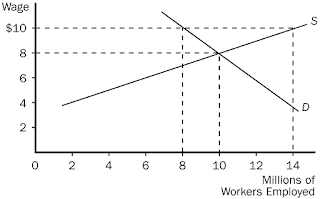
1. A difference in
wages that offsets differences in the nonpay features of two jobs is called
a. a compensating differential.
b. a wage adjustment.
c. an efficiency wage.
d. a minimum wage.
2. Working in a
slaughterhouse is much riskier than working in a bookstore. As a result, we’d
expect a difference in wages between the two jobs, which is known as
a. an efficiency wage.
b. a compensating differential.
c. a wage adjustment.
d. a minimum wage.
3. If a worker is
indifferent between a job with a wage of $12 per hour and a job with a wage of
$15 per hour, then the
a. higher-paying job enjoys a compensating wage differential
of $3 per hour.
b. higher-paying job enjoys a compensating wage differential
of $15 per hour.
c. lower-paying job is intrinsically more attractive than
the higher-paying job.
d. worker’s preferences are not rational.
4. Patrick is
considering two different jobs in the same city – one as a bicycle courier, and
the other as a mail room clerk. Both require equivalent training. He finds
neither job very appealing, but, if they pay the same wage rate, Patrick would
prefer to work as a mail room clerk. In order for Patrick to find the two jobs
equally attractive, the
a. mail room job must pay a compensating wage differential.
b. mail room job must pay an efficiency wage.
c. courier job must pay a compensating wage differential.
d. courier job must involve longer working hours.
5. Jobs that require
more costly training generally have
a. higher wages.
b. lower employment levels.
c. higher personal risk levels.
d. lower wages.
6. The time spent by
students in college
a. leads to lower lifetime earnings because opportunity
costs are high.
b. is an investment in human capital.
c. decreases human capital by lowering work experience.
d. increases as the low-skilled wage rate rises.
7. One reason why
individuals with greater ability receive higher wage rates is that they
a. face discrimination.
b. have lower marginal products.
c. have higher marginal products.
d. face diminishing marginal returns.
8. Technological
advances that increase the skill requirements for many jobs will tend to
a. make it more challenging for workers to migrate from
low-paying jobs to high-paying jobs.
b. make it easier for workers to migrate from low-paying
jobs to high-paying jobs.
c. contribute to a more equal distribution of income.
d. eliminate compensating wage differentials.
9. The fact that
movie star Julia Roberts’ salary is much higher than the salary earned by a
Nobel prize winning economics professor can best be explained by the
a. failure of the market to reward talent fairly.
b. fact that wage rates cannot reflect the influence of
education properly.
c. willingness of some people to accept a lower wage rate in
order to do what they like most to do.
d. superstar phenomenon.
10. Which of the
following is the most likely effect of minimum wage laws?
a. increase in the quantity of labor supplied by workers
b. decrease in the quantity of labor supplied by workers
c. increase in the quantity of labor demanded by firms
d. leftward shift in the demand curve for labor
11. It has been
argued that a “living wage” should be established by government, a wage that
would provide workers a reasonable standard of living in their city or region.
If a living wage of $10 per hour is established in the market described here,
we would expect
a. employment will increase to 14 million.
b. employment will decrease to 8 million.
c. the wage will actually rise to $20 per hour.
d. there will be a surplus of 14 million workers.

12. When unions are
successful in raising the wages of their members, the employers of the
unionized workers tend to
a. seek substitutes for union labor.
b. acquire less capital.
c. lower the prices of the goods they sell.
d. overcome the disadvantages of higher costs by lowering
management salaries.
13. The UMWA, a union
for coal miners, argues that the shift from coal to non-fossil fuels as an
energy source had a negative effect on coal miners’ incomes. This happened
because the
a. value of marginal product curve for labor shifted to the
right.
b. value of marginal product curve for labor shifted to the
left.
c. price elasticity of demand for coal decreased.
d. demand for coal shifted to the right.
14. This figure
depicts labor demand and supply in a nonunionized labor market. The original
equilibrium is at point A. If a labor union subsequently establishes a union
shop and negotiates an hourly wage of $20, then there will be an excess
a. supply of 3,000 workers.
b. demand of 7,000 workers.
c. supply of 4,000 workers.
d. supply of 7,000 workers.

15. This figure
depicts labor demand and supply in a nonunionized labor market. The original equilibrium
is at point A. If a labor union subsequently establishes a union shop and
negotiates an hourly wage of $20, then the employment level
a. rises from 6,000 to 10,000.
b. rises from 3,000 to 10,000.
c. drops from 10,000 to 3,000.
d. drops from 6,000 to 3,000.
16. The idea of
paying workers an efficiency wage is that
a. doing so is more efficient than paying them the market
wage.
b. paying workers less gives them the incentive to work harder.
c. workers and management gain at the expense of the
stockholders of the company.
d. workers have the incentive to do high-quality work.
17. If men, on
average, earn 20 percent more than women in a particular occupation,
a. this is clear evidence of discrimination.
b. some of this differential could be due to differences in
human capital.
c. most but not all of the differential is due to
discrimination.
d. comparable worth laws must be in effect.
18. When members of a
group enjoy different opportunities that cannot be attributed to differences in
ability,
a. discrimination is said to occur.
b. comparable worth laws are ineffective.
c. all wages in the market will be the same.
d. the demand for labor will increase.
19. If an employer
begins to pay higher wages to white workers, then in the short run
a. wages for white workers would fall.
b. wages for nonwhite workers would rise.
c. profits would rise as nonwhite workers leave the firm.
d. profits would fall as nonwhite workers leave the firm.
20. A labor market is
divided into two segments. All workers have the same qualifications and find
jobs in either segment equally attractive. Initially, both segments are in
competitive equilibrium. If the development of employer prejudice then reduces
the employment of minorities in one segment, there will be a
a. permanent drop in labor supply in the discriminating
segment.
b. permanent increase in labor supply in the
nondiscriminating segment.
c. temporary drop in labor supply in the discriminating
segment.
d. permanent drop in labor demand in the discriminating
segment.
21. A labor market is
divided into two segments. All workers have the same qualifications and find
jobs in either segment equally attractive. Initially, both segments are in
competitive equilibrium. Then the development of employer prejudice then
reduces the employment of minorities in one segment. In the long run, there
will likely be a change in
a. wage rates and the composition of the work force in both
segments.
b. neither wage rates nor the composition of the work force
in either segment.
c. wage rates but not the composition of the work force in
both segments.
d. the composition of the work force but not wage rates in
both segments.
22. Prejudice can
generate market forces that lead to a permanent shift of an unfavored minority
into low-wage jobs when the prejudice originates with
a. employees or customers.
b. employers, employees, or customers.
c. employees only.
d. customers only.
23. Market forces
encourage discrimination in the case of
a. statistical discrimination only.
b. employee and customer prejudice only.
c. employer prejudice only.
d. statistical discrimination and employee or customer
prejudice.
24. One difficulty
with the idea of comparable worth is that
a. it does not address the idea of compensating wage differentials.
b. it would cause wages to fall in many occupations.
c. a government agency cannot accurately evaluate the many
different characteristics of the many different jobs in the labor market.
d. it would not take into account differences in the demand
for labor among firms.
25. Comparable worth
policies can have effects similar to
a. efficiency wages in that employment may rise in the
affected markets.
b. minimum wages in that surpluses of labor may occur in the
affected markets.
c. government regulation in the case of natural monopolies.
d. economies of scale in that efficiencies are created by
increases in output.
No comments